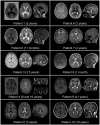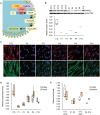Biallelic PI4KA variants cause a novel neurodevelopmental syndrome with hypomyelinating leukodystrophy
- PMID: 34415322
- PMCID: PMC8557332
- DOI: 10.1093/brain/awab124
Biallelic PI4KA variants cause a novel neurodevelopmental syndrome with hypomyelinating leukodystrophy
Abstract
Phosphoinositides are lipids that play a critical role in processes such as cellular signalling, ion channel activity and membrane trafficking. When mutated, several genes that encode proteins that participate in the metabolism of these lipids give rise to neurological or developmental phenotypes. PI4KA is a phosphoinositide kinase that is highly expressed in the brain and is essential for life. Here we used whole exome or genome sequencing to identify 10 unrelated patients harbouring biallelic variants in PI4KA that caused a spectrum of conditions ranging from severe global neurodevelopmental delay with hypomyelination and developmental brain abnormalities to pure spastic paraplegia. Some patients presented immunological deficits or genito-urinary abnormalities. Functional analyses by western blotting and immunofluorescence showed decreased PI4KA levels in the patients' fibroblasts. Immunofluorescence and targeted lipidomics indicated that PI4KA activity was diminished in fibroblasts and peripheral blood mononuclear cells. In conclusion, we report a novel severe metabolic disorder caused by PI4KA malfunction, highlighting the importance of phosphoinositide signalling in human brain development and the myelin sheath.
Keywords: PI4KA; hypomyelinating leukodystrophy; inborn errors of metabolism; phosphoinositol; spastic paraplegia.
© The Author(s) (2021). Published by Oxford University Press on behalf of the Guarantors of Brain.
Figures



References
-
- Burke JE. Structural basis for regulation of phosphoinositide kinases and their involvement in human disease. Mol Cell. 2018;71(5):653–673. - PubMed
Publication types
MeSH terms
Substances
Grants and funding
LinkOut - more resources
Full Text Sources
Molecular Biology Databases

